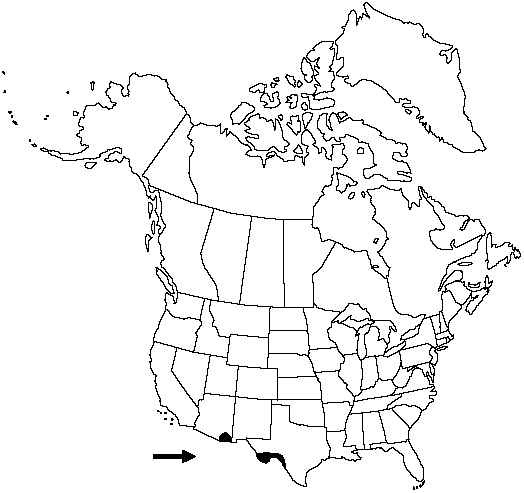Difference between revisions of "Notholaena neglecta"
Contr. U.S. Natl. Herb. 17: 602. 1916.
FNA>Volume Importer |
FNA>Volume Importer |
||
| Line 22: | Line 22: | ||
}}<!-- | }}<!-- | ||
| − | --><span class="statement" id="st- | + | --><span class="statement" id="st-undefined" data-properties=""><b>Stem </b>scales strongly bicolored, margins brown, broad and well defined, thin, ciliate-denticulate. <b>Leaves</b> 4–15 cm. <b>Petiole</b> black, equal to or somewhat longer than blade, rounded adaxially, bearing scattered glands and a few scales near base. <b>Blade</b> narrowly deltate-pentagonal, 3–4-pinnate, 1–2 times longer than wide, abaxially with conspicuous pale yellow farina, scales absent, adaxially glabrous to sparsely glandular; basal pinnae much larger than adjacent pair, strongly inequilateral, proximal basiscopic pinnules greatly enlarged. <b>Ultimate</b> segments sessile to subsessile, narrowly adnate to costae or free; segment margins strongly revolute, often concealing sporangia. <b>Sporangia</b> containing 32 spores. n = 2n = 90, apogamous.</span><!-- |
-->{{Treatment/Body | -->{{Treatment/Body | ||
| + | |phenology=Sporulating summer–fall. | ||
|habitat=Rocky slopes and cliffs, apparently confined to limestone | |habitat=Rocky slopes and cliffs, apparently confined to limestone | ||
|elevation=300–1900 m | |elevation=300–1900 m | ||
| Line 44: | Line 45: | ||
|basionyms= | |basionyms= | ||
|family=Pteridaceae | |family=Pteridaceae | ||
| + | |phenology=Sporulating summer–fall. | ||
|habitat=Rocky slopes and cliffs, apparently confined to limestone | |habitat=Rocky slopes and cliffs, apparently confined to limestone | ||
|elevation=300–1900 m | |elevation=300–1900 m | ||
| Line 51: | Line 53: | ||
|publication year=1916 | |publication year=1916 | ||
|special status= | |special status= | ||
| − | |source xml=https://jpend@bitbucket.org/aafc-mbb/fna- | + | |source xml=https://jpend@bitbucket.org/aafc-mbb/fna-data-curation.git/src/9216fc802291cd3df363fd52122300479582ede7/coarse_grained_fna_xml/V2/V2_487.xml |
|genus=Notholaena | |genus=Notholaena | ||
|species=Notholaena neglecta | |species=Notholaena neglecta | ||
| − | |||
| − | |||
| − | |||
| − | |||
| − | |||
| − | |||
| − | |||
| − | |||
| − | |||
| − | |||
| − | |||
| − | |||
| − | |||
| − | |||
| − | |||
| − | |||
| − | |||
| − | |||
| − | |||
| − | |||
| − | |||
| − | |||
| − | |||
| − | |||
| − | |||
| − | |||
| − | |||
| − | |||
| − | |||
}}<!-- | }}<!-- | ||
-->[[Category:Treatment]][[Category:Notholaena]] | -->[[Category:Treatment]][[Category:Notholaena]] | ||
Revision as of 14:21, 27 July 2019
Stem scales strongly bicolored, margins brown, broad and well defined, thin, ciliate-denticulate. Leaves 4–15 cm. Petiole black, equal to or somewhat longer than blade, rounded adaxially, bearing scattered glands and a few scales near base. Blade narrowly deltate-pentagonal, 3–4-pinnate, 1–2 times longer than wide, abaxially with conspicuous pale yellow farina, scales absent, adaxially glabrous to sparsely glandular; basal pinnae much larger than adjacent pair, strongly inequilateral, proximal basiscopic pinnules greatly enlarged. Ultimate segments sessile to subsessile, narrowly adnate to costae or free; segment margins strongly revolute, often concealing sporangia. Sporangia containing 32 spores. n = 2n = 90, apogamous.
Phenology: Sporulating summer–fall.
Habitat: Rocky slopes and cliffs, apparently confined to limestone
Elevation: 300–1900 m
Distribution

Ariz., Tex., Mexico.
Discussion
Notholaena neglecta is closely related to N. californica and may have been involved in the origin of polyploids within that complex. Populations occurring in the flora are composed of apogamous triploids, but a sexually reproducing diploid cytotype has been found in Nuevo León, Mexico (M. D. Windham, unpublished data).
Selected References
None.